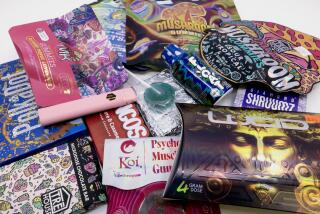THE PHARM REPORT : The Medical Line Between Yuck and Yum
- Share via
The taste of medicine doesn’t affect how well it works. But it could mean the difference between the potion sitting in the medicine cabinet or landing in your gut. And when it comes to kiddie pills and potions, taste can make a parent feel guilty--or competent.
Manufacturers know this and have been striving for years to make medicines palatable enough to stomach--but not so tasty you’ll fantasize about your next dose.
“You don’t want the kids to like it so much that they sneak the stuff,” says Don Jenkins, a chemist at Summit Industries Inc., which manufactures Creomulsion cough syrup.
It’s a complicated tightrope.
The Cover-Up
Masking the taste of medicines is getting easier, Jenkins says; ingredients have improved in taste. Certain flavors are better than others at covering up the unpleasantness of it all, industry insiders say. Beyond that, some medicine-makers count on consumers to acquire a palate for their less-than-tasty formulas.
“Black cherry can do the most to cover up the sins of drugs,” claims Bill Zick, vice president of marketing for the New Jersey-based flavor division of International Flavors and Fragrances Inc., New York, one of numerous “flavor houses” that sell to drug companies.
“We can do a much broader, much better job today than we could 20 years ago,” he says.
Artificial vs. Natural
Artificial flavors come through “more strongly” than natural ones, says Jenkins. Ever since World War II, the trend has been away from natural flavors in medicines. So if your medicine is cherry-flavored, don’t bet the taste ever grew on a tree.
Kid vs. Grown-Up Taste
Flavors that appeal to kids don’t necessarily get high marks from their parents--and vice versa. Kids like the same tastes in medicines that they crave in candies, says Zick. Right now, that means super sour medicines and candies with “pucker power.”
“Kids are interested in very strange flavors right now,” he says, predicting that the next hip flavor for children’s medicine will be something like “blue raspberry,” a combination blueberry and raspberry.
Meanwhile, adults lean toward citrus flavors, Zick says. Lemon and orange with honey are big sellers in over-the-counter medicines.
Making the Medicine Slide Down
Parents who serve on manufacturers’ tasting panels often say they want palatable children’s medicines so their kids won’t bolt when it’s time for the next dose. “Adults are seeking efficacy from (their own) medicine,” Jenkins says, “but parents are seeking domestic tranquillity. Parents feel real guilty when they have to fight with a kid about medicine. We had some moms telling us about sitting on their kids (to get the medicine down).”
To avoid that kind of acrobatic activity at Childrens Hospital Los Angeles, pharmacists there rely on wild cherry syrup, says Christopher Lomax, director of pharmacy services. “When we have to crush tablets for kids, we often mix wild cherry syrup with the pills and make a kind of pill slurry.”
Nurses serve as VIP tasters, he adds. If two manufacturers bid the same fee for the same drug, Lomax says, he’ll try to buy the better-tasting formula. “We’ll get both drugs in, take them to the nurses and let them taste and pick. They have to give it to the kids.”
Water Chasers
Drinking water won’t diminish the effectiveness of the active ingredient in the cough syrup, Jenkins says, but it might rinse away the throat-coating effect of the syrup.
Acquired Tastes
Sometimes manufacturers don’t even try to dress up the taste even if they acknowledge it’s pretty disgusting. There is a perception among some people that sweet-tasting medicine might not work as well. Creomulsion cough syrup comes to mind. “It’s pretty strong tasting stuff,” admits Jenkins. But it helps, he says, to have “an acquired taste.”
Beyond Taste
Pharmacists and manufacturers advise picking a cough syrup to treat your particular type of cough. Read box labels. Some formulas are for dry coughs, others for coughs that produce phlegm. Some formulas are meant to relieve nasal stuffiness and other symptoms.
A Spoonful of Sugar Helps Syrup Go Down
The Scoop: Every year, we spoon $450 million worth of non-prescription cough syrup, says Kathryn Griffie of Kline & Co., a New Jersey-based international business consulting firm.
The Dilemma: How to pick a cough syrup from more than 100 options. Taste is one way, since many cough formulas contain the same active ingredients but vary the inactive ingredients and flavoring. After all, if you’re hacking your way through the day, why make things worse with a terrible aftertaste?
The Solution: We rounded up a Taste Test Panel of Three and asked them to try four top-selling syrups--Robitussin DM and CF, Vicks Formula 44D and 44M, and one less popular syrup, Creomulsion.
They gave us their honest--and unscientific--reactions.
On the Panel:
* Christopher Lomax, 45, director of pharmacy services for Childrens Hospital Los Angeles.
* Susan Yan, 26, assistant court information officer for the Los Angeles Municipal Court.
* Carmen DeArtola, 26, special assistant at Maxicare.
The Results: There was no high praise for any formula, and some were described as “disgusting.”
Vicks’ Formula 44D (No. 3 in sales according to Kline & Co. statistics) was No. 1 with the panel.
“A smooth taste and was easy to swallow.” (DeArtola)
“It tastes good, sweet and slightly minty.” (Yan)
“It seems to have a eucalyptus-like ingredient, because when you inhale it feels cool in your mouth.” (Lomax)
Vicks Formula 44M (No. 4 in sales) was described as “disgusting” by Yan and “not pleasant” by DeArtola. Lomax thought it tasted bad, but not as bad as Robitussin CF (No. 2 in sales).
His fellow panel members weren’t enamored of Robitussin CF either. Yan called it “bitter, raspy, hard to swallow” because of its taste. It tasted like mouthwash to DeArtola.
Robitussin DM (No. 1 in sales) was termed too strong by DeArtola and too bitter by both Lomax and Yan.
Creomulsion, on the market since 1920 and touted as a natural cough syrup, won no praise. It’s no surprise that it’s near the bottom of the Kline & Co. list.
“It tastes like black licorice and reminds me of castor oil.” (Yan)
“It tastes like a root of some type but I can’t place it. Maybe licorice or coal tar.” (Lomax)
DeArtola remembered tasting something similar when she was 5--a taste that “did not bring back fond memories.”
More to Read
Sign up for Essential California
The most important California stories and recommendations in your inbox every morning.
You may occasionally receive promotional content from the Los Angeles Times.









